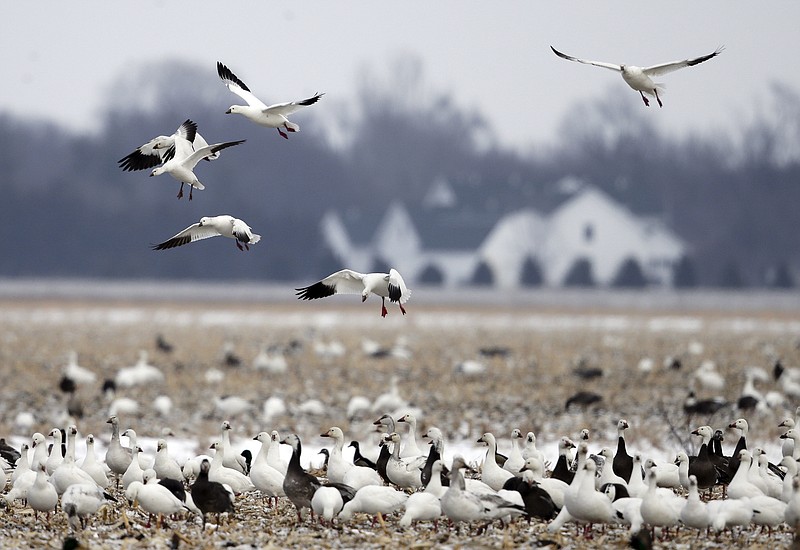"The good old days are now." — Tom Clancy
I used to get tired of hearing about the good old days.
Older hunters and fishermen are the world's worst when it comes to relating how great it was in the "good old days. "I don't hear this so much anymore; maybe it is because I have become one of the old guys who talk about how great it used to be!
As far as wildlife and game populations go, in many respects we are better off now than 50 years ago. Deer and turkeys, no question. Our small game? Well, that is a story for another time.
In one area of waterfowl hunting, however, we are completely off the charts, and that is with snow geese. Known as "light geese" in the waterfowl identification world, this group includes the greater and lesser snow goose, the Ross's goose and some variations, including hybrids of these geese.
This is somewhat of a long story, but in a nutshell what occurred is by the late 1990s, wildlife biologists were noticing that snow geese populations were expanding at an alarming rate. Most of these geese migrate to the far north on the tundra, where they spend the spring and summer. Snow geese, especially the greater snow goose, can cause great damage to the habitat they feed in. Geese are grazers and pull different grasses and plants out of the ground while feeding. They will also dig into the soil with their powerful beaks to extract groceries.
This may not sound like a big deal until you think about oh, say 10,000 geese descending on one field. That is the kind of numbers these geese may travel in.
The arctic tundra where these birds nest is very fragile, with a short growing season. The snow goose was literally eating himself out of house and home, and just not himself, but all the other birds and animals that inhabit the same area.
Something had to give.
Long story short, the U.S. Fish and Wildlife Service was able to change some rules to allow for a much greater harvest of light geese. This meant much longer seasons (107 days in some states) extending into March. Restrictions on plugged shotguns and electronic callers were deleted. They wanted hunters to knock down some geese!
What has emerged in the past 15 years or so is a new genre of waterfowl hunting. Even though it begins in February, it is considered spring hunting as the season often runs into March and April depending on what state you are in. Hunters who are obsessed with this (believe me, these guys are out there) basically start in the South, Texas and Arkansas (in the Mississippi flyway) and follow the white geese north on their migration.
I wanted to talk to someone on the snow goose trail, and I found Josh Dahlke lying in a muddy field in Arkansas. Josh runs the popular online resource ScoutLook Weather. This is the cat's meow for keeping hunters and fisherman updated on the latest weather and conditions for your area, along with tons of information and articles on whatever kind of hook and bullet arena that you play in.
Josh was snow goose hunting with Eaglehead Outdoors outfitters; these guys are the real deal and chase the snow geese north from February to April.
"I know that the geese cause damage to the tundra when they get to their breeding grounds," Josh told me. "But here in the states, in agricultural fields, the damage that they can do to crops, you just have to see it to believe it.
"We found a huge flock of snows staged next to a 40-acre winter wheat field here in Arkansas. By the next day, that field was totally obliterated, nothing left but mud."
Even though the snow geese flocks can number in the thousands, Josh was quick to point out that this is not always an easy game.
"These birds get shot at all the way to Canada," he said. "They have seen decoy spreads all along the route. They can be dang smart. To be successful at this, it takes a lot of work, driving hundreds of miles and scouting, finding the geese and then setting up massive spreads of decoys.
"The few dozen decoys most duck hunters are used to just won't do it — it takes hundreds, and a thousand is better."
If that sounds out of your abilities, you're not alone.
"The average hunter can't do it," Josh explained. "That's why if you want to try this, you may want to give an outfitter a call."
Even though we are talking millions of geese here, hunting is still hunting, and there are no guarantees. When conditions are right, however, you can stack up a lot of snow geese. Josh told about one afternoon when his party took 64 birds, and sometimes the numbers go much higher than that, depending on how many are in your party. The daily limit in some states is 25, and I believe it is 50 in Texas.
I may not make it on a snow goose hunt this year (but I might). I still have some squirrel hunting to do and then will think about spring turkey season. If you want to go after snow geese, you might want to get in touch with the guys at Eaglehead Outdoors.
I hope you get to shoot so much that you burn the barrel off that shotgun.
"Guns & Cornbread" is written by Larry Case, who lives in Fayette County, W.Va. You can write to him at larryocase3@gmail.com.
